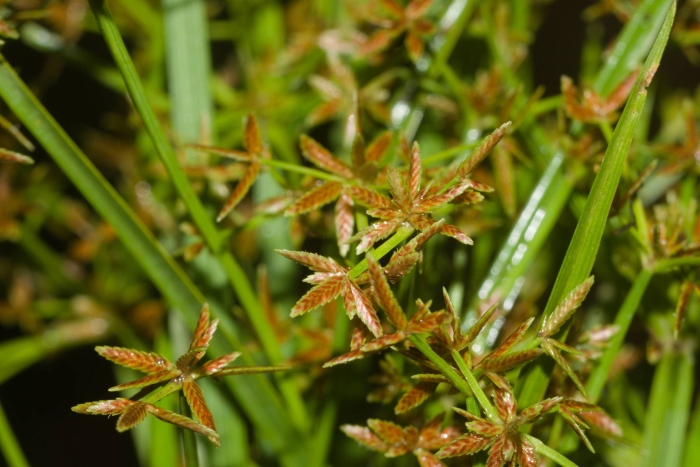Haspan Flat Sedge
(Cyperus haspan)
Haspan Flat Sedge (Cyperus haspan)
/
/

© Kevin Faccenda
CC BY 4.0
Image By:
© Kevin Faccenda
Recorded By:
Copyright:
CC BY 4.0
Copyright Notice:
Photo by: © Kevin Faccenda | License Type: CC BY 4.0 | License URL: http://creativecommons.org/licenses/by/4.0/ | Uploader: kevinfaccenda | Publisher: iNaturalist |

























Estimated Native Range
Summary
Cyperus haspan, commonly known as Haspan Flat Sedge, is a perennial herbaceous plant native to a wide range of wetland habitats including marshes, wet meadows, pond margins, and riverbanks in tropical and subtropical regions worldwide. This includes Africa, Asia, Australia, and the southeastern United States. It typically grows 1 to 2 feet tall, forming dense clumps of slender, grass-like foliage. The plant produces small, greenish-brown flower clusters atop triangular stems during the summer months, though the flowers are not particularly showy.
Haspan Flat Sedge is valued for its ability to thrive in wet conditions and is often used in water gardens, rain gardens, and as a soil stabilizer along waterways. It prefers full sun to part shade and requires consistently moist to wet soil conditions. While it is not demanding in terms of soil type, it does best in gravelly, sandy-clay soils with good water retention. Cyperus haspan is easy to maintain, but gardeners should be cautious as it can be potentially invasive outside its native range, particularly in similar wetland environments. It is advisable to manage its spread to prevent it from outcompeting native vegetation.CC BY-SA 4.0
Haspan Flat Sedge is valued for its ability to thrive in wet conditions and is often used in water gardens, rain gardens, and as a soil stabilizer along waterways. It prefers full sun to part shade and requires consistently moist to wet soil conditions. While it is not demanding in terms of soil type, it does best in gravelly, sandy-clay soils with good water retention. Cyperus haspan is easy to maintain, but gardeners should be cautious as it can be potentially invasive outside its native range, particularly in similar wetland environments. It is advisable to manage its spread to prevent it from outcompeting native vegetation.CC BY-SA 4.0
Plant Description
- Plant Type: Grass
- Height: 2-3 feet
- Width: 1-2 feet
- Growth Rate: Moderate, Slow
- Flower Color: N/A
- Flowering Season: Spring, Summer, Fall
- Leaf Retention: Evergreen
Growth Requirements
- Sun: Full Sun, Part Shade
- Water: High, Aquatic
- Drainage: Standing
Common Uses
Border Plant, Low Maintenance, Potted Plant, Water Garden
Natural Habitat
Wetland habitats including marshes, wet meadows, pond margins, and riverbanks in tropical and subtropical regions
Other Names
Common Names: Dwarf Papyrus , Dwarf Umbrella Sedge , Dwarf Papyrus Sedge
Scientific Names: Cyperus haspan , Cyperus adenophorus , Cyperus adenophorus , Cyperus adenophorus subsp. aphyllus , Cyperus adenophorus var. aphyllus , Cyperus americanus , Cyperus aphyllus , Cyperus autumnalis , Cyperus caespitosus , Cyperus cayennensis
GBIF Accepted Name: